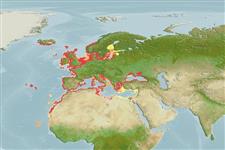Common names from other countries
分类 / Names
俗名 | 同种异名 | Catalog of Fishes(属, 种) | ITIS | CoL | WoRMS | Cloffa
Teleostei >
Beloniformes (Needle fishes)
頜針魚目 (Needle fishes) >
Belonidae (Needlefishes)
頜針魚科 (Needlefishes)
Etymology: Belone: Greek, belone = needle; any fish with sharp pointed snout; also Pierre Belon, 1517-64, French zoologist born in Le Mans. Professor at the College de France, author of " La nature et diversité des poissons", 1551 (Ref. 45335).
More on author: Linnaeus.
Issue
According to authors cited by Evenhuis (1997: Ref. 115711: 480-482), the date of publication of the species should be 1760.
Environment: milieu / climate zone / depth range / distribution range
生态学
海洋; 半咸淡水; 海洋洄游的 (Ref. 51243); 深度上下限 2 - 22 m (Ref. 130220). 溫帶; 65°N - 14°N, 32°W - 42°E
Eastern Atlantic and Mediterranean Sea. Three subspecies were recognized by Collette and Parin (1970, Ref. 34977) Belone belone belone (Linnaeus, 1761) (Northeast Atlantic); Belone belone euxini Günther, 1866 (Black Sea and Sea of Azov); Belone belone acus Risso, 1827 (Mediterranean Sea and adjacent parts of Atlantic Ocean, Madeira, Canary Islands, Azores, and south to Cape Verde (Ref. 50279); subspecies Belone belone gracilis Lowe, 1839 (France to the Canary Islands including the Mediterranean) in Collette & Parin, 1990 (Ref. 5757).
東大西洋與地中海。 三個亞種被辨識特徵為 Collette 與 Parin(1970, 參考文獻 34977) 頜針魚〔Belone belone〕 belone(林奈,1761)(東北大西洋); 頜針魚〔Belone belone〕 euxini Gunther,1866(黑海與亞速海); 頜針魚〔Belone belone〕 acus Risso,1827(地中海與大西洋,馬得拉群島,加納利群島,亞速群島的毗連部份, 而且南至維德角;(參考文獻 50279) 亞種 頜針魚〔Belone belone〕 gracilis Lowe,1839(法國到加納利群島包括地中海) 在 Collette&Parin,1990.(參考文獻 5757)
Length at first maturity / 大小 / 重量 / 年龄
Maturity: Lm ? range ? - ? cm
Max length : 104 cm TL 雄鱼/尚未辨别雌雄; (Ref. 123983); common length : 45.0 cm SL 雄鱼/尚未辨别雌雄; (Ref. 3397); 最大体重: 1.4 kg (Ref. 113079)
背棘 (总数) : 0; 背的软条 (总数) : 16 - 20; 臀鳍软条: 19 - 23. Jaw teeth comparatively large and widely spaced. Vertebrae 75-84. Vomerine teeth present at lengths greater than 20 cam. Lower jaw a little longer than upper jaw. Juveniles with greatly elongated jaw, without black posterior dorsal fin lobe.
颌齿比较大与空隙大的。 脊椎骨 75-84. 有锄骨齿最后大于 20个凸轮。 下颌稍微比上颌长。 稚鱼有非常细长的颌, 没有黑色的在后部的背鳍叶。
Lives close to the surface and has a migratory pattern similar to the mackerel (Ref. 35388). Feeds on small fishes, particularly clupeids and Engraulis (in the Black Sea). Leaps out of the water when hooked. Oviparous (Ref. 205). Eggs may be found attached to objects in the water by tendrils on the egg's surface (Ref. 205). Utilized fresh and frozen; can be fried, broiled and baked (Ref. 9988). Minimum depth reported taken from Ref. 130219.
生活于接近表面而且有一个回游的形态类似鲭.(参考文献 35388) 吃小鱼, 特别地鲱鱼与 Engraulis.(在黑海) 当钩住,从水中跳出来。 卵生的.(参考文献 205) 卵可能被发现于在卵的表面上的卷须水依附于目标。 (参考文献 205) 生鲜使用与冷冻; 能被油炸, 火烤而且烧烤。 (参考文献 9988)
Oviparous (Ref. 205).東大西洋與地中海。 三個亞種被辨識特徵為 Collette 與 Parin(1970, 參考文獻 34977) 頜針魚〔Belone belone〕 belone(林奈,1761)(東北大西洋); 頜針魚〔Belone belone〕 euxini Gunther,1866(黑海與亞速海); 頜針魚〔Belone belone〕 acus Risso,1827(地中海與大西洋,馬得拉群島,加納利群島,亞速群島的毗連部份, 而且南至維德角;(參考文獻 50279) 亞種 頜針魚〔Belone belone〕 gracilis Lowe,1839(法國到加納利群島包括地中海) 在 Collette&Parin,1990.(參考文獻 5757)
Collette, B.B. and N.V. Parin, 1986. Belonidae. p. 604-609. In P.J.P. Whitehead, M.-L. Bauchot, J.-C. Hureau, J. Nielsen and E. Tortonese (eds.) Fishes of the north-eastern Atlantic and the Mediterranean, Volume 2. Unesco, Paris. (Ref. 5505)
CITES (Ref. 128078)
Not Evaluated
人类利用
渔业: 商业性; 游钓鱼种: 是的
工具
特别资料
下载 XML
网络资源
Estimates based on models
Preferred temperature (Ref.
115969): 8.8 - 20, mean 11.3 (based on 548 cells).
Phylogenetic diversity index (Ref.
82804): PD
50 = 0.6250 [Uniqueness, from 0.5 = low to 2.0 = high].
Bayesian length-weight: a=0.00105 (0.00085 - 0.00129), b=3.08 (3.02 - 3.14), in cm Total Length, based on LWR estimates for this species (Ref.
93245).
营养阶层 (Ref.
69278): 4.2 ±0.4 se; based on diet studies.
回复力 (Ref.
120179): 中等的, 族群倍增时间最少 1.4 - 4.4年 (tm=2; Fec=1000).
Prior r = 0.43, 95% CL = 0.28 - 0.64, Based on 6 data-limited stock assessments.
Fishing Vulnerability (Ref.
59153): Moderate to high vulnerability (49 of 100).
Climate Vulnerability (Ref.
125649): High vulnerability (58 of 100).
